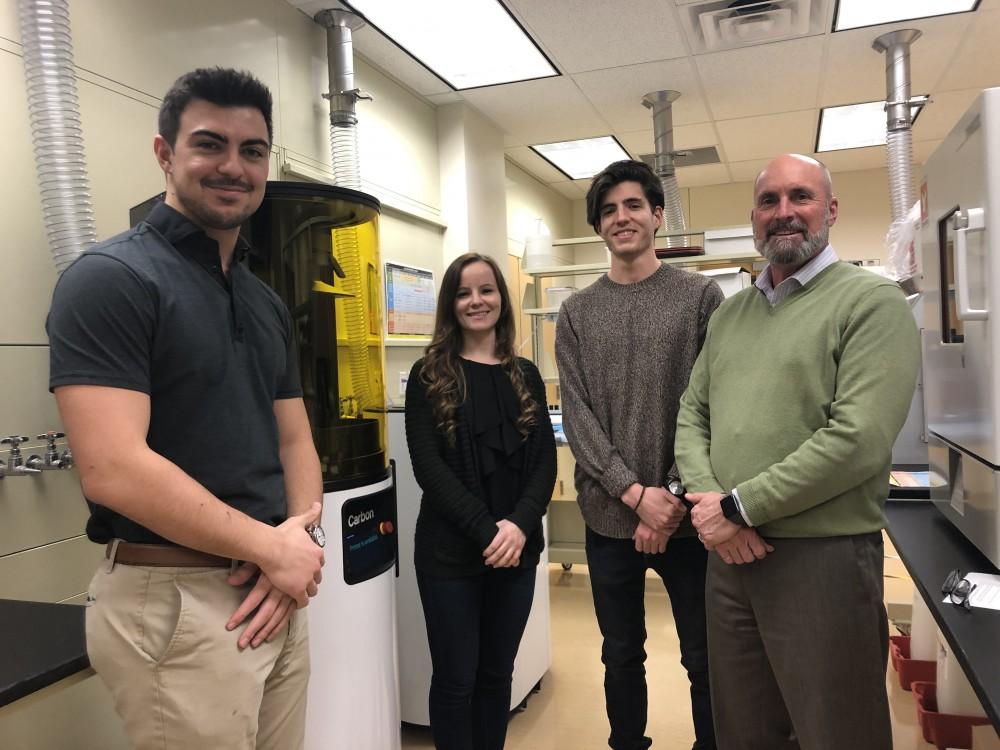Applied Medical Device Institute earns $500,000 grant

GVL / Rachel Matuszewski
Jan 28, 2019
The Grand Valley State University College of Engineering was recently awarded $500,000 by the Grand Rapids SmartZone to create medical devices from the new Carbon, Inc. 3D printer.
The Local Development Finance Authority (LDFA) promotes small businesses to get through their first years, otherwise known as “the valley of death.” The LDFA manages Tax Incremental Funding (TIF) money within the city of Grand Rapids. They also sort through proposals and ask if they are good for the city, retain talent and help develop their infrastructure.
GVSU’s applied Medical Device Institute (aMDI) submitted this proposal in partnership with MediSurge and Carbon, Inc. two years ago, with the planning and preparation taking a year.
“(The) $500,000 grant to afford this technology (helps) us bring more technology, industry and innovation to Grand Rapids,” said aMDI co-opt student Nah Keefer. “We’re one of six universities that has this type of technology.”
GVSU co-opt engineering students, GVSU faculty and MediSurge and aMDI employers can experience the printer, which sits in aMDI’s incubator room in the Cook-DeVos Center for Health Sciences. For now, the printer’s main purpose lies in creating small medical devices that can go underneath the skin at a rapid pace.
“MediSurge is trying to eliminate the number of suppliers we have,” MediSurge co-opt student Breanna Andrews said. “When we get a new mold component, we have to purchase a mold, which will create the shape of whatever component that we need and then we do validations and verifications to make sure that the component is manufacturing correctly. The point of this is to eliminate the front end cost to have a quicker turnaround time from start to finish.”
Depending on the height of the mold, employees can make as many products that can fit in the platform, which can hold up to 15 inches of resin, the chemical mixture poured into the mold for printing. The printer projects UV light onto the resin and dries it until the part is formed.
The resin structure is then taken to wash off the remaining toxic resin, twice. Finally, it is cured in UV heat or UV light to make the product non-toxic and safe to touch. Two part resins are placed under UV heat, called baking, and can take eight to 12 hours to cure. One part resins are placed under UV light and can take up to two minutes.
The end result is called polymers, a material similar to plastic. With the printer’s precision, employees can design a variety of materials to meet the design criteria, from flexible and elastic to solid and rigid.
Executive Director of applied Medical Device Institute Brent Nowak said the same material is used in the sole of Adidas shoes.
For GVSU faculty, this provides them the opportunity to help aMDI with their expertise and publish papers. For GVSU engineering students, the new technology gives them an advantage for hiring when graduation is in sight. Students like Aldo Fanelli are learning to not only build polymers, but to create theses on how to break them.
“They work on real world problems at industry pace (in) project immersion,” Nowak said.
“They get all the theory in the classroom but then they come in here and they have to solve real world problems. When they graduate, they have worked in industry already, they understand the difference between the academic teaching and the real world application. It’s good for our mission and our mission is student-centric around teaching and enhanced learning abilities.”






















